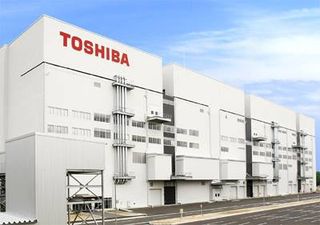Toshiba, SanDisk Announce 48-Layer 3D BiCS TLC NAND
Toshiba and SanDisk's Flash Forward partnership is ready to populate the newly constructed Fab 5 in Yokkaichi, Japan. Both companies announced new 3bit-per cell (X3) Bit Cost Scaling (BiCS) Flash with 48-layers on an unknown lithography process node.

Flash Forward plans to follow Samsung with Charge Trap technology, which holds up to eight charge levels for TLC. IMFT (Intel Micron Flash Technology) is the only company to continue down the floating gate path. SK Hynix started to develop floating gate 3D NAND but shifted focus due to cost and how difficult it is to develop the technology.
Last March, the companies announced 128 Gbit MLC BiCS FLASH. Work first started on 3D BiCS FLASH back in 2007, but only recent has manufacturing processes and technology caught up with ideas on the table. 3D flash is coming at the optimal time, as 2D flash has reached its plateau for development with current manufacturing processes.
The new 3bit-per-cell BiCS just announced increases the number of layers to forty-eight, and the die density to 256 Gbit. That's 32 GB in the size of your pinky fingernail. Companies can already stack up to sixteen die in a package. Our calculator tells us that's 512 GB of TLC NAND flash per package. Companies often use up to 16 packages in high-performance client SSDs. If everything works as intended, we could very well see 8 TB client SSDs within the next two years.
Unknown at this time is the lithography process the companies plan to build BiCS FLASH on at first. Samsung's 3D V-NAND technology is currently on 3x nm (30nm to 40nm). Samsung ships 16nm 2D planar NAND that competes with Flash Forward's 15nm planar process node. Similarly, IMFT has 16nm planar NAND but has been reluctant to specify the process node for next generation 3D flash. The secret sauce makes it difficult to compare next generation flash against each other for pricing.
By the time Toshiba and SanDisk release BiCS, IMFT and SK Hynix will also have 3D NAND flash in production. 2016 will be an interesting time, as the focus for client SSDs moves away from performance; companies plan to take on mainstream priorities, which are capacity and cost. These are areas currently dominated by mechanical disks. In order for flash to compete, production volume needs to increase. At this time, flash trails disks in capacity shipped by a large margin.
Toshiba, Micron and Samsung have all either ramped up production in new factories or have plans to in the coming months. The new factories spread across the globe not only increase production but also enable new flash technology like BiCS to bear fruit.
Stay on the Cutting Edge
Join the experts who read Tom's Hardware for the inside track on enthusiast PC tech news — and have for over 25 years. We'll send breaking news and in-depth reviews of CPUs, GPUs, AI, maker hardware and more straight to your inbox.
Chris Ramseyer is a Contributing Editor for Tom's Hardware, covering Storage. Follow him on Twitter and Facebook. Follow Tom's Hardware on Twitter, Facebook and Google+.
Most Popular







